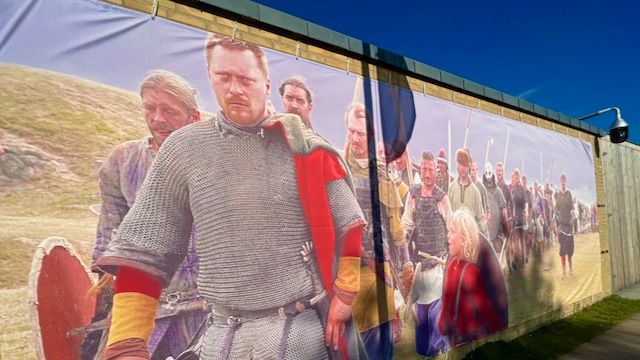Timeless Trelleborg
On the picturesque, windswept coast of Denmark’s Zealand region, is Slagelse, a charming little town that seems to blend history, culture and natural beauty, without much effort.
Now, there are plenty of charming little towns in Denmark, so what makes Slagelse special? In fact, what am I doing here?

A Viking fort, that’s what. Trelleborg ring fort, to be specific.

Back in the day, i.e. about 1,100 years ago, today’s Scandinavia was practically a super power, with strong ties to the Holy Roman Empire, England, and the Slavic territories. And the Vikings were the first to establish towns in this region.
Vikings and the world
They also got around, those Vikings. They travelled, conquered and colonised. Some of them pillaged, others were out to do business, others again settled in the foreign lands. And one way or another, it resulted in learning each other’s customs and social structures – and sharing cultural identity and a bit of DNA.
dialect (meaning) – Old Norse (also, present-day Norwegian) word
- ban (swear) – banne
- barn (child) – barn
- beck (stream, brook) – bekk
- dale (valley) – dal
- flit (move house) – flytte
- lig (lie down) – ligge
- nay (no) – nei
But whilst many Vikings hang up their…erm, helmet abroad, others brought people back home with them. Here at Trelleborg, there is evidence that Denmark was a multiethnic society 1,000 years ago. Researchers have looked at 48 skeletons found here, and strontium isotope analyses show that more than half of them were not from here.
The theory is that foreigners were recruited as mercenaries. And perhaps they brought their families with them. Some of the female skeletons were also found to be of foreign origin.

Trelleborg Museum of the Viking Age
Life at the ring fort
I am here to have a look at this whole thing: the ring fortress from the time of Harald Bluetooth, the king who christened Denmark, and to get an idea of life 1,000 years ago.

All ring fortresses are constructed according to the same consistent design principles: strict, geometrical architecture and symmetrical layout. The one here in Trelleborg is one of the best-preserved in Denmark, and this 10th century garrison gives an interesting insight into Viking military architecture.

The site also has reconstructed Viking houses, including the all-important longhouse.


Wandering through the reconstructed Viking village, you can get a tangible experience of life in the 10th century.

Inside at the museum are archaeological artefacts, if you want a deeper look at the Viking history here.

Despite the idyllic surroundings, life wasn’t easy in Viking Era Denmark. The work was hard, and food not sufficiently nutritious. Infant mortality was high, and women frequently died giving birth. The skeletons here at Trelleborg show an average life expectancy below 50 years; the oldest one buried here was ca. 55.

Trelleborg before the ring fort and the Vikings
An on-site info board, tells me the inhabitants of the fortress were not the first to live on this headland. In fact, Trelleborg has been an important site since the Late Stone Age. The earliest traces of habitation are 5,000 years old, and stem from what was presumably a cult centre. The complex here, consisted of a large enclosure protected by a wooden palisade and long trenches in a double row along the perimeter. Similar cult complexes from this era have been discovered all over Northern Europe.

What else?
If you’re getting tired of history, or perhaps you want to contemplate it further, I can recommend a stroll anywhere along the coast here. Accompanied by sea breeze and views of the Baltic, it’s a meditative experience. It’s easy to imagine the Vikings of this region wandering along the coast here 1,000 years ago.
Trelleborg practicals

- I hired a car at CPH and drove to Trelleborg in one hour. Public transport is also possible, though of course not as flexible. Regional trains leave Copenhagen Central Station for Slagelse frequently, taking about 1hr 10min. From Slagelse Station, take bus 49 to Trelleborg – or walk the 3 km.
- The little café at Trelleborg Museum has strong Danish coffee and wienerbrød (literally Vienna bread), i.e. Danish pastries. If you want something more substantial, local cuisine offers fresh catch from the Baltic Sea.
- Trelleborg puts on an annual summer Viking Festival, where enthusiasts reenact Viking life complete with period costumes. This year’s festival (2024) is scheduled for 13 – 21 July.
- You can find up to date opening hours and entrance fees for Trelleborg Museum of the Viking Age here.

Viking-Age Ring Fortresses is a UNESCO World Heritage site.
Here are more UNESCO World Heritage sites around the world.
Timeless Trelleborg is a post from Sophie's World



